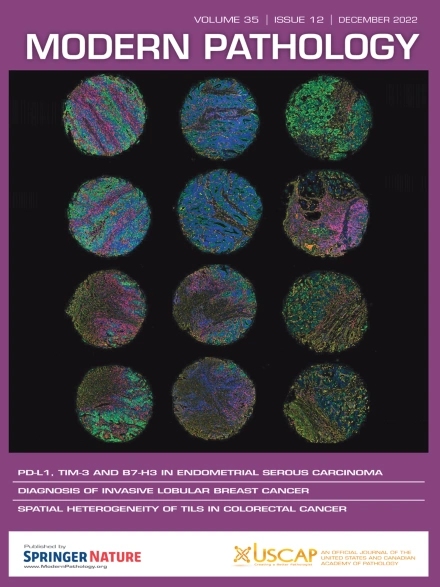Primary Vulvar and Vaginal Adenocarcinomas of Intestinal Type Are Closer To Colorectal Adenocarcinomas Than To Carcinomas of Müllerian Origin
IF 5.5
1区 医学
Q1 PATHOLOGY
引用次数: 0
Abstract
Primary vulvar and vaginal adenocarcinomas of intestinal type (VVAIts) are very rare tumors, displaying morphologic and immunohistochemical overlap with colorectal adenocarcinomas. However, their immunoprofile and genomics are poorly studied, and their origin is still debated. Here, we studied a series of 8 VVAIts (4 vulvar and 4 vaginal) using a large panel of immunohistochemistry and DNA and RNA sequencing with clustering analyses. All tumors shared a similar morphology with colorectal adenocarcinomas and diffuse CK20 and CDX2 expression. SATB2 diffuse positivity was observed in 62.5% of tumors and CK7 in 82.5%, whereas PAX8, SOX17, p16, and estrogen and progesterone receptors were always negative. A p53 mutated-type expression was observed in 75% of tumors. All tumors were mismatch repair proficient. Neither human papillomavirus DNA nor pathogenic transcript fusions were detected. The most frequent molecular alterations were TP53 and KRAS variants in 71.4% and 42.9%, respectively. The transcriptomic analysis highlighted a robust VVAIts cluster distinct from endocervical, ovarian, lung, thyroid, salivary glands, breast, and renal carcinomas but failed to differentiate vulvar from vaginal intestinal-type tumors. On 2 different clustering analyses, VVAIts clustered altogether, very close to colorectal adenocarcinomas. Compared with endocervical adenocarcinomas of intestinal type, VVAIts had a significantly lower expression of SOX17 and epithelial-mesenchymal transition genes and a higher mitogen-activated protein kinase pathway gene expression. These results suggest that Müllerian structures leading to cervical adenocarcinomas may undergo intestinal-type transdifferentiation via an epithelial-mesenchymal transition phenomenon. Conversely, mitogen-activated protein kinase pathway activation in VVAIts, which plays a major role in colorectal adenocarcinomas, may indicate a close relationship in the carcinogenesis of these tumors. Our results indicate that adenocarcinomas of intestinal type, in the distal vagina or vestibular vulva, might be a unique and single entity, probably originating from cloacogenic embryonic remnants and/or ectopic colorectal mucosae inclusions. An open question would be to explore the efficacy of systemic drugs prescribed in colorectal cancers, in VVAIts.
原发性外阴和阴道肠型腺癌更接近结肠直肠腺癌,而不是穆勒氏来源的癌。
原发性外阴和阴道肠型腺癌(VVAIts)是一种非常罕见的肿瘤,在形态学和免疫组化方面与结直肠腺癌重叠。然而,人们对它们的免疫谱和基因组学研究甚少,对它们的起源也仍有争议。在本文中,我们对一系列 4 例外阴和 4 例阴道肠型腺癌进行了研究,采用了大量的免疫组化、DNA 和 RNA 测序以及聚类分析。所有肿瘤的形态与结直肠腺癌相似,CK20和CDX2弥漫表达。62.5%的肿瘤呈SATB2弥漫阳性,82.5%的肿瘤呈CK7弥漫阳性,而PAX8、SOX17、p16、雌激素和孕激素受体始终呈阴性。在 75% 的肿瘤中观察到 p53 突变型表达。所有肿瘤都具有 MMR 能力。未检测到HPV DNA或致病性转录本融合。最常见的分子改变是TP53和KRAS变异,分别占71.4%和42.9%。转录组分析突出显示了一个强大的VVAIts集群,有别于宫颈内膜癌、卵巢癌、肺癌、甲状腺癌、唾液腺癌、乳腺癌和肾癌,但未能区分外阴癌和阴道肠型肿瘤。在两种不同的聚类分析中,VVAIts聚类在一起,与结直肠腺癌非常接近。与肠型宫颈内膜腺癌相比,VVAIs的SOX17和上皮-间质转化(EMT)基因表达量明显较低,而MAP-激酶通路基因表达量较高。这些结果表明,导致宫颈腺癌的Müllerian结构可能通过EMT现象发生肠型转分化。相反,MAP-激酶通路在 VVAIts 中被激活,而 VVAIts 在结直肠腺癌中起着重要作用,这可能表明这两种肿瘤的发生有着密切的关系。我们的研究结果表明,阴道远端或前庭大阴道的肠型腺癌可能是一个独特的单一实体,可能起源于泄殖腔胚胎残余和/或异位结肠直肠粘膜包涵体。一个悬而未决的问题是,探讨治疗结直肠癌的全身用药对 VVAIs 的疗效。
本文章由计算机程序翻译,如有差异,请以英文原文为准。
求助全文
约1分钟内获得全文
求助全文
来源期刊

Modern Pathology
医学-病理学
CiteScore
14.30
自引率
2.70%
发文量
174
审稿时长
18 days
期刊介绍:
Modern Pathology, an international journal under the ownership of The United States & Canadian Academy of Pathology (USCAP), serves as an authoritative platform for publishing top-tier clinical and translational research studies in pathology.
Original manuscripts are the primary focus of Modern Pathology, complemented by impactful editorials, reviews, and practice guidelines covering all facets of precision diagnostics in human pathology. The journal's scope includes advancements in molecular diagnostics and genomic classifications of diseases, breakthroughs in immune-oncology, computational science, applied bioinformatics, and digital pathology.
 求助内容:
求助内容: 应助结果提醒方式:
应助结果提醒方式:


